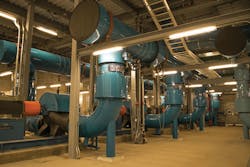This case highlights the tremendous value that Stanford’s Central Energy Facility (CEF) realized because of its move from time-based preventive maintenance to condition-based predictive maintenance (PdM).
Background
Nestled in the heart of the Silicon Valley, Stanford University is one of the most reputed educational and research institutions in the world. Stanford completed the reconstruction of its 125,000 square-foot CEF in 2015. The idea was to replace the previous fossil fuel-based system with grid-sourced electricity and a first-of-its-kind, high-efficiency heat recovery system to foster sustainability, energy efficiency and carbon reduction.
Transforming the campus-wide distribution system was a massive endeavor. It required converting 22 miles of steam pipes to hot-water pipelines across the entire 8,000-acre campus, in addition to retrofitting 155 buildings.
The results are impressive: Greenhouse gas emissions are slashed by 68 percent; fossil fuel use by 65 percent; and campus- wide water use by 15 percent. This comprehensive Stanford Energy System Innovation (SESI) system is expected to eliminate 150,000 tons of carbon dioxide emissions annually, the equivalent of removing 32,000 cars from the road every year. Expected energy savings to Stanford over a 35-year period is $425 million.
To achieve these goals, Stanford’s energy facility utilizes a fleet of critical pumps to supply hot and cold water to the entire university, including Stanford School of Medicine and Lucile Packard Children’s Hospital.
Challenge
Meeting the enormous water supply demands across the nearly 13-square mile campus came with its own set of challenges. Moreover, as the team scaled operations, the CEF experienced unplanned downtime and loss of productivity caused by critical machine failures.
The CEF needed to closely monitor equipment health to maintain round the clock uptime. It used a preventive maintenance system that involved timebased inspection and repair of all critical machinery repair.
The facility’s engineers at the facility quickly realized their current maintenance model was ineffective and they turned to innovative Industrial Internet of Things- (IIoT) based solutions to optimize maintenance costs and improve equipment reliability. The big question was: If machine failures do not follow a set pattern, why does a maintenance program need to follow one?
The CEF began looking for state-of-the-art predictive maintenance technologies to monitor its critical machinery.
Goals
Stanford’s CEF maintenance team set the following criteria to evaluate various predictive maintenance solutions:
- Simplicity and short time-to-deploy — Stanford wanted a PdM system that was simple to install and quick to launch. The team did not want to incur the expenses of wiring traditional sensors to the building control systems. Additionally, the university did not want to undertake any custom IT projects just to visualize sensor data.
- Elimination of manual data collection — Some of the wireless PdM offerings that Stanford evaluated still involved manual data collection. The CEF looked for technology that continuously monitored the machines and fully automated the data collection process.
- Easy access to real-time insights — Finally, and perhaps most importantly, the CEF team wanted to receive immediate alerts when a machine deviated significantly from its P-F curve. It was also valuable for them to track the utilization of machines to maximize equipment life cycles. This information needed to be accessible anytime from mobile devices or computers.
Solution & benefits
After a thorough evaluation, Stanford deployed an end-to-end industrial internet-based PdM solution that included state-of-the-art wireless sensors and cloud-based predictive analytics. Stanford’s energy facility installed triaxial vibration sensors, connected them to the facility’s Wi-Fi network and began receiving data and actionable intelligence in real time.
The system began building a baseline to determine machine health. This proprietary machine learning process took place in the cloud, where multiparameter data are stored and analyzed for trends and anomalies. Engineers were able to view the vibration data instantly with web and mobile applications. With a color-coded machine health dashboard, the CEF team could focus on the machinery that needed attention.
As a result, Stanford’s reliability team can focus on deteriorating machines and gain insights into equipment utilization. Now they are able to increase the equipment lifespan by equally distributing the use of these pumps.
Key highlights included:
1. Wireless sensing
As IIoT technologies become pervasive, internet-connected sensors are readily available and more affordable than ever. For the industrial world, this means that all critical machinery can be easily instrumented for continuous monitoring. Today wireless sensors are the obvious choice since they help avoid wiring costs and safety concerns.
Benefits:
- Deployment is simple and affordable.
- Data is collected more frequently and precisely with minimal human effort.
2. Cloud-based architecture
On the surface, the cost savings of having a cloud-based system are apparent. With affordable remote infrastructure, plants and facilities do not need to invest capital in building an on-premise data center. Today cloud service providers offer superior, enterprise-level security to traditional IT departments. They also allow the flexibility to start small and scale up as usage increases. Further, industrial operations call for round-the-clock monitoring, even when personnel are off-site. Web and mobile interfaces provide maintenance teams with remote access to health of critical machinery and equipment.
Benefits:
- Implementation is quick and cost-effective.
- The system can be readily accessible from any device at any time.
3. Automated data analysis
While wireless sensors generate petabytes of data, the need for automated analysis becomes evident. Advanced machine learning algorithms can automate basic analysis and enable quick detection of anomalies within massive amounts of sensor data. As a result, machine learning can quickly identify faulty machines so analysts may focus on more complex diagnostics.
Benefits:
- Reduces costs associated with redundant preventive maintenance
- Eliminates unplanned downtime by catching defects as early as possible
- Lowers costs associated with manual analysis
Conclusion
This solution enabled Stanford’s CEF to monitor its entire fleet of critical pumps in real time. Within weeks of installation, the machine learning algorithms were able to detect anomalies and prevent significant failures. Stanford has now rolled out continuous vibration monitoring across the entire facility, which protects against early stage mechanical failures. Next steps would involve obtaining a holistic picture of machine health by correlating vibration with other parameters like pressure and current. This data-driven approach can help Stanford’s energy facility significantly reduce costs associated with traditional preventive maintenance.
With actionable diagnostics in real time, IIoT and machine learning technology makes it possible to continuously monitor and assess the health of critical rotating machines like pumps and compressors.
By utilizing automated analysis as a first line of defense, facilities can utilize personnel to focus on problem machines and complex diagnostics, avoiding redundant maintenance time. While this strategy applies to all industries, it is particularly useful to those that rely heavily on the movement of fluid loads, such as oil and gas, power generation, and critical facilities management. With current trends in sensing and machine learning technologies, a shift toward wireless condition monitoring is imminent. The age of industrial internet and predictive maintenance has arrived.
Abhinav Khushraj is cofounder of Petasense and heads product and engineering. He brings more than a decade of experience in business development, strategy and product and engineering built at iconic companies like Nokia and Citrix.
Arun Santhebennur is cofounder of Petasense and heads sales and marketing. He brings more than 15 years of experience in building high-tech startups in the enterprise software space. He holds an MBA from IIM Calcutta. For more information, visit petasense.com.




